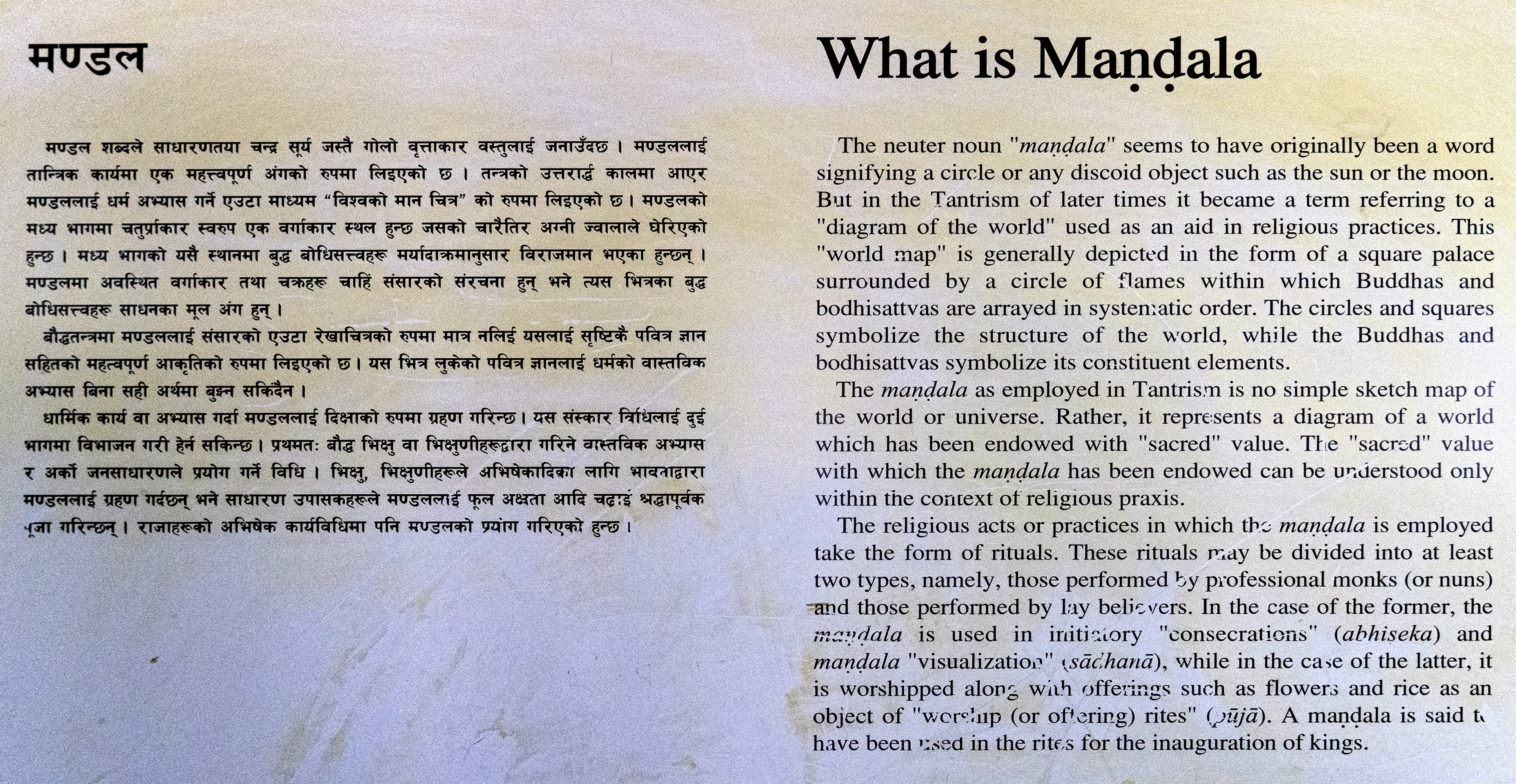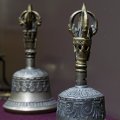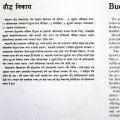Buddhist Art Gallery: Northern Himalayan Section: photo 105
Photo 105 of 198 in Gallery: Buddhist Art Gallery: Northern Himalayan Section

Image title: What is Mandala (text)
Description of the photo
English text:
The neuter noun "mandala" seems to have originally been a word signifying a circle or any discoid object such as the sun or the moon. But in the Tantrism of later times it became a term referring to a "diagram of the world" used as an aid in religious practices. This "world map" is generally depicted in the form of a square palace surrounded by a circle of flames within which Buddhas and Bodhisattvas are arrayed in systematic order. The circles and squares symbolize the structure of the world, while the Buddhas and Bodhisattvas symbolize its constituent elements.
The mandala as employed in Tantrism is no simple sketch map of the world or universe. Rather, it represents a diagram of a world which has been endowed with "sacred" value. The "sacred" value with which the mandala has been endowed can be understood only within the context of religious praxis.
The religious acts or practices in which the mandala is employed take the form of rituals. These rituals may be divided into at least two types, namely, those performed by professional monks (or nuns) and those performed by lay believers. In the case of the former, the mandala is used in initiatory "consecrations” (abhiseka) and mandala "visualization" (sadhana), while in the case of the latter, it is worshipped along with offerings such as flowers and rice as an object of "worship (or offering) rites" (puja). A mandala is said to have been used in the rites for the inauguration of kings.
Nepalese text (not proofread)
मण्डल शब्दले साधारणतया चन्द्र सूर्य जस्तै गोलो वृत्ताकार वस्तुलाई जनाउँदछ । मण्डललाई तान्त्रिक कार्यमा एक महत्त्वपूर्ण अंगको रुपमा लिइएको छ । तन्त्रको उत्तरार्द्ध कालमा आएर मण्डललाई धर्म अभ्यास गर्ने एउटा माध्यम " विश्वको मान चित्र" को रुपमा लिइएको छ । मण्डलको मध्य भागमा चतुप्रकार स्वरुप एक वर्गाकार स्थल हुन्छ जसको चारैतिर अग्नी ज्वालाले घेरिएको हुन्छ । मध्य भागको यसै स्थानमा बुद्ध बोधिसत्त्वहरू मर्यादाक्रमानुसार विराजमान भएका हुन्छन् । मण्डलमा अवस्थित वर्गाकार तथा चक्रहरू चाहिँ संसारको संरचना हुन् भने त्यस भित्रका बुद्ध बोधिसत्त्वहरू साधनका मूल अंग हुन् ।
बौद्धतन्त्रमा मण्डललाई संसारको एउटा रेखाचित्रको रुपमा मात्र नलिई यसलाई सृष्टिकै पवित्र ज्ञान सहितको महत्वपूर्ण आकृतिको रुपमा लिइएको छ । यस भित्र लुकेको पवित्र ज्ञानलाई धर्मको वास्तविक अभ्यास बिना सही अर्थमा बुझ्न सकिंदैन ।
धार्मिक कार्य वा अभ्यास गर्दा मण्डललाई दिक्षाको रुपमा ग्रहण गरिन्छ । यस संस्कार विधिलाई दुई भागमा विभाजन गरी हेर्न सकिन्छ । प्रथमतः बौद्ध भिक्षु वा भिक्षुणीहरूद्वारा गरिने वास्तविक अभ्यास र अर्को जनसाधारणले प्रयोग गर्ने विधि । भिक्षु, भिक्षुणीहरूले अभिषेकादिका लागि भावनाद्वारा मण्डललाई ग्रहण गर्दछन् भने साधारण उपासकहरूले मण्डललाई फूल अक्षता आदि चढाई श्रद्धापूर्वक पूजा गरिन्छन् । राजाहरूको अभिषेक कार्यविधिमा पनि मण्डलको प्रयोग गरिएको हुन्छ ।
Nepalese to English (automated translation)
The word mandala usually refers to a circular object like the moon and the sun. Mandal is considered as an important part in tantric work. In the latter period of Tantra, the mandala has been considered as a means of practicing religion as "the symbol of the world". In the middle part of the mandala there is a square place in the shape of a quadruped, which is surrounded by fire flames. Buddha Bodhisattvas are seated in this place in the middle part according to the order of dignity. The squares and circles present in the mandala are the structure of the world, while the Buddha Bodhisattvas within it are the basic parts of the instrument.
In Buddhism, the mandala is not only taken as a diagram of the world, but it is taken as an important figure containing the sacred knowledge of creation. The sacred knowledge hidden in it cannot be properly understood without the actual practice of religion.
During religious work or practice, the mandala is accepted as initiation. This rite of passage can be divided into two parts. First is the actual practice by Buddhist monks or nuns and the second is the method used by the general public. Monks and nuns receive the mandala by emotion for abhishekadi, while ordinary worshipers worship the mandala by offering flowers akshata etc. Mandalas are also used in the consecration of kings.
Transcription (with diacritics):
maṇḍala śabdale sādhāraṇatayā candra sūrya jastai golo vṛttākāra vastulāī janāuṃdacha . Maṇḍalalāī tāntrika kāryamā eka mahattvapūrṇa aṃgako rupamā liieko cha . Tantrako uttarārddha kālamā āera maṇḍalalāī dharma abhyāsa garne euṭā mādhyama " viśvako māna citra" ko rupamā liieko cha . Maṇḍalako madhya bhāgamā catuprakāra svarupa eka vargākāra sthala huncha jasako cāraitira agnī jvālāle gherieko huncha . Madhya bhāgako yasai sthānamā buddha bodhisattvaharū maryādākramānusāra virājamāna bhaekā hunchan . Maṇḍalamā avasthita vargākāra tathā cakraharū cāhiṃ saṃsārako saṃracanā hun bhane tyasa bhitrakā buddha bodhisattvaharū sādhanakā mūla aṃga hun.
bauddhatantramā maṇḍalalāī saṃsārako euṭā rekhācitrako rupamā mātra naliī yasalāī sṛṣṭikai pavitra jñāna sahitako mahatvapūrṇa ākṛtiko rupamā liieko cha . Yasa bhitra lukeko pavitra jñānalāī dharmako vāstavika abhyāsa binā sahī arthamā bujhna sakiṃdaina.
dhārmika kārya vā abhyāsa gardā maṇḍalalāī dikṣāko rupamā grahaṇa garincha . Yasa saṃskāra vidhilāī duī bhāgamā vibhājana garī herna sakincha . Prathamataḥ bauddha bhikṣu vā bhikṣuṇīharūdvārā garine vāstavika abhyāsa ra arko janasādhāraṇale prayoga garne vidhi . Bhikṣu, bhikṣuṇīharūle abhiṣekādikā lāgi bhāvanādvārā maṇḍalalāī grahaṇa gardachan bhane sādhāraṇa upāsakaharūle maṇḍalalāī phūla akṣatā ādi caḍhāī śraddhāpūrvaka pūjā garinchan . Rājāharūko abhiṣeka kāryavidhimā pani maṇḍalako prayoga garieko huncha .
Transcription (without diacritics):
mandala shabdale sadharanataya candra surya jastai golo vrittakara vastulai janaumdacha . mandalalai tantrika karyama eka mahattvapurna amgako rupama liieko cha . tantrako uttararddha kalama aera mandalalai dharma abhyasa garne euta madhyama " vishvako mana citra" ko rupama liieko cha . mandalako madhya bhagama catuprakara svarupa eka vargakara sthala huncha jasako caraitira agni jvalale gherieko huncha . madhya bhagako yasai sthanama buddha bodhisattvaharu maryadakramanusara virajamana bhaeka hunchan . mandalama avasthita vargakara tatha cakraharu cahim samsarako samracana hun bhane tyasa bhitraka buddha bodhisattvaharu sadhanaka mula amga hun.
bauddhatantrama mandalalai samsarako euta rekhacitrako rupama matra nalii yasalai srishtikai pavitra jnana sahitako mahatvapurna akritiko rupama liieko cha . yasa bhitra lukeko pavitra jnanalai dharmako vastavika abhyasa bina sahi arthama bujhna sakimdaina.
dharmika karya va abhyasa garda mandalalai dikshako rupama grahana garincha . yasa samskara vidhilai dui bhagama vibhajana gari herna sakincha . prathamatah bauddha bhikshu va bhikshuniharudvara garine vastavika abhyasa ra arko janasadharanale prayoga garne vidhi . bhikshu, bhikshuniharule abhishekadika lagi bhavanadvara mandalalai grahana gardachan bhane sadharana upasakaharule mandalalai phula akshata adi cadhai shraddhapurvaka puja garinchan . rajaharuko abhisheka karyavidhima pani mandalako prayoga garieko huncha .
Gallery information:
The Northern Himalayan region in Nepal offers a wide variety of Buddhist objects such as paintings, scriptures, sculptures, ritualistic objects, etc. Buddhism once entered Tibet from Nepal and has blended in its own way there, resulting in Tibetan Buddhism which is divided into many schools. The items found here are exhibited in the National Museum of Nepal (Rashtriya Museum).
Photo details:
Date: 2019-12-04
Camera: SONY ILCE-6400
Exposure: 1/160
Aperture: f/3.5
ISO: 2000
Focal length: 18mm
High resolution:
Download file
Size: 5.60 MB
Resolution: 3867 x 2000
© Photograph by Gabe Hiemstra.
License: CC BY-NC-ND 4.0

